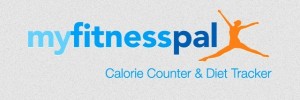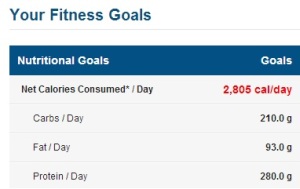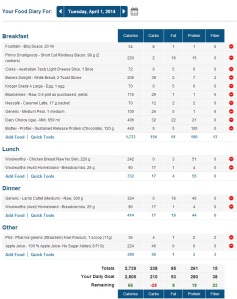So here is where I provide you with the necessary tools to firstly, calculate your daily caloric needs, secondly, select an appropriate deficit and thirdly select macro-nutrient ratios for your goal. I will also provide you with a sample dietary plan.
Firstly lets re-cap on how it is we as human lose weight, as we learnt in Fueling the body, it all comes down to the energy equation and caloric theory. In order to lose weight we must be consuming less energy via food than what we need to sustain our metabolic functions and physical activity; and of course the opposite applies for gaining weight. So the first thing we must do it calculate our daily caloric needs.
Calculating daily caloric needs
There are a number of way to do this, most take into consideration age, weight, height, gender, activity or body-fat. Despite there differences they all output fairly similar calorie estimates. Now to save you doing math just yet(you will be required to a little later on) I have linked you to a decent calculator here. Mess around with the different equations(click the advanced button) and notice how the numbers vary depending on the equation. This is because it is only an estimate and must be tweaked depending on progress or non progress. I can’t stress the previous point enough.
Selecting an appropriate calorie deficit
Now we have the our daily caloric need, the next step to weight loss is choosing an appropriate calorie deficit. Once again there are several ways to do this, some like to use the daily caloric estimate for your goal weight, others use percentages of you daily caloric value. Ideally especially if you are already overweight you want to be using percentages, so the drop in calories is not too drastic. These deficits can be categorized into three groups;
Small 15-20% deficit
The advantages of having a small deficit are only minor changes are needed in dietary intake to arrive at the deficit, making it easier to adhere too, less impact on training performance, less metabolic resistance and hormonal down regulation. However the rate of fat-loss is very slow, and as the deficit is so small a minor mistake in calculations can erase the deficit.
Recommended for: Specific case/athletes
Length of time: Long
Medium 20-25% deficit
A medium deficit ensures a faster rate of fat-loss and less likelihood of obliterating the deficit via miscalculation, while still being fairly obtainable with only moderate dietary restrictions. However there is a higher impact on training performance, although not profound and increased metabolic resistance and hormonal down regulation.
Recommend for: Average case/Normal or overweight
Length of time: Medium
Large >Greater than 25%
Larger deficits obliviously lead to faster weight loss however require major dietary intake changes. They also have greater effects on training performance, metabolic resistance and hormonal down regulation. This is not something you want to be doing long term. The good news is no matter how bad you miscalcualte you will almost always still be at a deficit.
Recommend for: Extreme cases/obesity
Length of time: Short
Selecting macro-nutrient ratios
Like the other steps in this journey there are several different ways to select macro-nutrient ratios, seeing as we have already used percentages we may as well stick with that theme. The idea behind selecting macro-nutrient ratios is to provide your body with enough protein to prevent lean muscle loss, enough fats to maintain hormonal regulation and enough carbohydrates to fuel physical activity. If you are left scratching your head at this point you probably haven’t read the lead up articles Introduction to nutrition and calories, Calories, Kilo-calories, joules and kilo-joules. A fairly standard set of percentages is 40/30/30. That is 40% protein, 30%fats, 30%carbohydrates, these can be tweaked somewhat however this is a good starting point.
Converting to grams per day
Now we have our required daily caloric intake, have selected an appropriate deficit and have sorted our macro-nutrient ratios. However food labels usually do not measure macro-nutrients in terms of calories, they instead measure macro-nutrients via grams and let you figure out the rest. So if we remember back to reading calories, Calories, Kilo-calories, joules and kilo-joules, each macro-nutrient was assigned a caloric value per gram. They are as follow:
1 g of carbohydrate = 16.7kJ (4 Cal)
1g of fat = 37.7 kJ (9 Cal)
1g of protein = 16.8 kJ (4 Cal)
1g of alcohol = 29.3kJ (7 Cal)
1g fibre = 6.3-8.37kJ(1.5-2 Cal)
As we are only worrying about proteins, fats and carbohydrates, don’t pay too much attention to the others, let me worry about them. In order to convert our calculated macro-nutrient ratios from calories to grams we simply divide by the caloric value. So if we require 903 calories daily from protein and we want to know how many grams per day that equals to, we divide by 4, giving us 225.7. Simple. Now don’t get to caught up on the .7, leaving it out will not result in a disastrous miscalculation but merely will lead to a loss or gain of a few calories. This is no big deal, in fact I usually have a leeway of a few hundred calories in all my dietary programs.
It is at this stage I would like to state the above is a very very simple way of calculating calories, deficits and macro-nutrients, often a great starting point but by no means the be all and end all. There are several more complex and accurate ways to calculate these variables which would lead to greater success. If you are interested in obtaining figures via the more complex methods or just can’t be bothered doing the math, let me do it for you here.
Okay so now we have our daily figures, we must try and hit these figures regularly on a daily basis. To begin with this can be somewhat tedious but necessary, the idea is by counting calories, weighing food and tracking macro-nutrients either via labels or online(also available on smartphones) we learn correct portion sizes for weight-loss and eventually when we hit our goal, weight maintenance. The lack of understanding about portion sizes is why so many countries including ours suffer high obesity rates. Learning how much food is necessary to fuel your body and it’s daily activities is THE fundamental ingredient to dropping the rate of obesity. However the above is not just for the obese, it can be used for anybody wanting to improve their body composition and aesthetics.
I have gone ahead and taken the above steps using my age, weight, height, gender and activity level to produce a dietary guide.
1.Calculating daily caloric needs
Maintenance calories: 2821
2.Select an appropriate calorie deficit
Caloric deficit: 20%
Calories at deficit: 2257
3. Select macro-nutrient ratios
40/30/30
Calories: 2257
Protein: 903 calories
Fat: 677 calories
Carbohydrates: 677 calories
4.Converting to grams per day
40/30/30
Calories: 2257
Protein: 225g/pd
Fat: 75g/pd
Carbohydrates: 169g/pd
TADA! I now have my very own personalized figures for weight loss. Give it a try using your own statistics and stick with it for at-least 4 weeks, if you aren’t seeing changes in the mirror try a higher calorie deficit, but don’t do anything to absurdly high. If you still are not seeing results or simply want me to do your calculations for you visit here
Now while hitting these targets regularly will lead to weight-loss, food choices play a fairly important role in health which is something we should always be mindful of, so I beg you, please read guide to flexible dieting.
Finally there are a number of different FREE tools on the internet, from food databases to calorie counters and meal planners, below I will provide a list of the ones I find most helpful.
http://www.freedieting.com/tools/calorie_calculator.htm
http://www.myfitnesspal.com/
http://www.eatthismuch.com/
http://www.calorieking.com.au/
http://runkeeper.com/
 Upon signing up I will create for you a free myfitnesspal.com account. We will discuss via email your goals, training, current diet, schedule, food preferences and anything else that may impact the plan. During this process, I will educate you on the fundamentals of nutrition, exercise and supplementation and ensure you understand the process. Don’t let that frighten you, I teach only as much as you want to learn. After careful planning and lots of math, I will come up with custom calorie and macro-nutrient figures. I will then enter these on your account on myfitnesspal. (below)
Upon signing up I will create for you a free myfitnesspal.com account. We will discuss via email your goals, training, current diet, schedule, food preferences and anything else that may impact the plan. During this process, I will educate you on the fundamentals of nutrition, exercise and supplementation and ensure you understand the process. Don’t let that frighten you, I teach only as much as you want to learn. After careful planning and lots of math, I will come up with custom calorie and macro-nutrient figures. I will then enter these on your account on myfitnesspal. (below) From there I will create a one day food intake plan, which will hit your calorie and macro-nutrient figures, showing you what a regular day eating within your personal figures would entail. (below) I also give you detailed guide on how to use myfitnesspal to track your figures, including tips and tricks to make the entire process far simpler.
From there I will create a one day food intake plan, which will hit your calorie and macro-nutrient figures, showing you what a regular day eating within your personal figures would entail. (below) I also give you detailed guide on how to use myfitnesspal to track your figures, including tips and tricks to make the entire process far simpler. Now with a solid foundation knowledge of why we are aiming for these figures and how to meet them, I leave you to track your calorie and macro-nutrient figures on a daily basis. I keep a watchful eye on your progress by logging in daily, weekly or monthly* to ensure you are correctly hitting your figures, not making mistakes and to make any adjustments based upon progression and results.
Now with a solid foundation knowledge of why we are aiming for these figures and how to meet them, I leave you to track your calorie and macro-nutrient figures on a daily basis. I keep a watchful eye on your progress by logging in daily, weekly or monthly* to ensure you are correctly hitting your figures, not making mistakes and to make any adjustments based upon progression and results.
